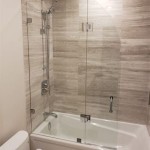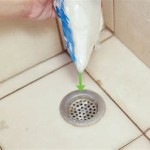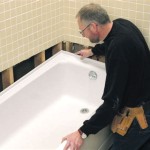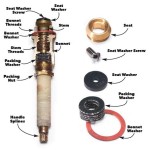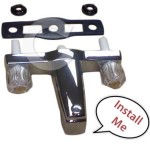My Bathtub Is Clogged With Hair: A Comprehensive Guide to Identification and Remediation
A clogged bathtub drain is a common household problem, and hair is frequently the primary culprit. The accumulation of hair, often combined with soap scum, oils, and other debris, can create a dense blockage that restricts water flow and ultimately leads to a completely clogged drain. Understanding the mechanics of hair clogs, identifying the signs, and implementing appropriate solutions are crucial for maintaining a functional and hygienic bathroom environment.
Prevention is undoubtedly the best approach to dealing with hair clogs. However, despite best efforts, clogs can still occur. Therefore, a multi-faceted approach encompassing preventative measures and effective remediation techniques is essential.
Identifying the Signs of a Hair Clog
Recognizing the early warning signs of a hair clog can prevent a minor issue from escalating into a major plumbing problem. Several indicators suggest the presence of a developing obstruction within the bathtub drain.
Slow Drainage: The most obvious sign is water draining slower than usual after emptying the bathtub or shower. This indicates that something is partially obstructing the drainpipe, restricting the flow of water. As more hair and debris accumulate, the drainage will become progressively slower.
Gurgling Sounds: Gurgling or bubbling sounds emanating from the drain while water is draining or even when no water is running can indicate a partial blockage. These noises are caused by air being forced through the obstructed drainpipe as water attempts to pass through.
Standing Water: If water remains in the bathtub long after the faucet has been turned off, a significant clog is likely present. This indicates that the drainage system is severely restricted, preventing water from escaping at a reasonable rate. This can also lead to unsanitary conditions as soap scum and other residues accumulate in the standing water.
Unpleasant Odors: A foul odor emanating from the drain is a strong indication of decomposing organic matter trapped within the drainpipe. Hair, combined with soap scum and other bathroom waste, can create an ideal breeding ground for bacteria, which release unpleasant smells.
Water Backup: In severe cases, water may begin to back up into the bathtub drain, especially when other plumbing fixtures in the house are used. This signifies a significant blockage downstream, preventing water from flowing freely through the drainage system.
If any of these signs are observed, prompt action is necessary to address the potential hair clog before it worsens.
Methods for Removing Hair Clogs
Several methods can be employed to remove hair clogs from bathtub drains, ranging from simple DIY techniques to more involved plumbing interventions. The choice of method depends on the severity of the clog and the tools available.
Manual Hair Removal: This is the most straightforward approach, especially for clogs located near the drain opening. A bent wire hanger or a specialized drain snake (also known as a plumbing snake) can be used to manually extract the hair and debris. The process involves inserting the tool into the drain, rotating it to catch the hair, and then gently pulling it out. Repeating this process multiple times may be necessary to completely clear the clog. Care should be taken to avoid pushing the clog further down the drainpipe.
Plunger: A standard cup plunger can be effective for dislodging minor hair clogs. The plunger creates suction, which can help to break up and dislodge the blockage. Ensure there is enough water in the tub to cover the cup of the plunger. Place the plunger firmly over the drain opening and pump it vigorously up and down for several minutes. Remove the plunger to see if the water drains. Repeat the process if necessary. This method works best when there is a good seal between the plunger and the drain opening.
Baking Soda and Vinegar: This natural solution can be effective for breaking down minor clogs. Pour approximately one cup of baking soda down the drain, followed by one cup of white vinegar. The mixture will fizz and bubble. Let it sit for about 30 minutes, then flush the drain with hot water. The chemical reaction between the baking soda and vinegar can help to dissolve hair and other organic matter. This method is a gentler alternative to harsh chemical drain cleaners.
Boiling Water: Pouring boiling water down the drain can help to melt away soap scum and dissolve some types of hair products. However, this method should be used with caution, as it can damage PVC pipes. If the plumbing system is older or made of materials other than PVC, this method should be avoided. Even with PVC pipes, it is advisable to run warm water first to preheat the pipes and reduce the risk of thermal shock.
Chemical Drain Cleaners: Chemical drain cleaners are readily available at most hardware stores and supermarkets. These products contain harsh chemicals that can dissolve hair and other organic matter. However, they should be used with extreme caution, as they can damage pipes, cause burns, and release toxic fumes. Always follow the instructions on the label carefully and wear protective gear, such as gloves and eye protection. Frequent use of chemical drain cleaners can weaken pipes and lead to more serious plumbing problems in the long term.
Drain Snake (Plumbing Snake): A drain snake is a flexible tool designed to reach further into the drainpipe and break up or retrieve clogs. It is more effective than a wire hanger for reaching deeper into the drain system. Different types of drain snakes are available, including manual and motorized versions. Insert the snake into the drain and rotate it as it goes down the pipe. When you encounter resistance, continue rotating the snake to break up the clog or to hook onto it. Carefully pull the snake out, removing the hair and debris. Repeat this process until the drain is clear.
P-Trap Removal: The P-trap is the curved section of pipe located under the bathtub drain. It is designed to trap debris and prevent sewer gases from entering the bathroom. If other methods have failed, removing and cleaning the P-trap may be necessary. Place a bucket under the P-trap to catch any water and debris. Loosen the slip nuts that connect the P-trap to the drainpipes. Carefully remove the P-trap and clean out any accumulated hair and debris. Reassemble the P-trap and tighten the slip nuts. Run water to check for leaks.
Professional Plumber: If all other methods fail, or if there is a concern about damaging the plumbing system, it is best to call a professional plumber. A plumber has the expertise and specialized tools to diagnose and resolve complex drain clogs safely and effectively. They can also identify and address any underlying plumbing issues that may be contributing to the recurring clogs.
Preventative Measures to Minimize Hair Clogs
Preventing hair clogs is significantly easier and more cost-effective than dealing with existing blockages. Implementing preventative measures can significantly reduce the frequency of drain problems and maintain a healthy plumbing system.
Drain Screens: The most basic and effective preventative measure is to install a drain screen or strainer in the bathtub drain. These inexpensive devices catch hair and other debris before they enter the drainpipe. Regularly clean the drain screen to remove accumulated hair and prevent it from building up and causing a clog.
Hair Catchers: Specialized hair catchers are available that are designed to trap even more hair than standard drain screens. These devices often feature a basket or container that can be easily removed and emptied. They are particularly useful for individuals with long hair or for households with multiple people using the same bathtub.
Regular Cleaning: Regularly flush the drain with hot water to help dissolve soap scum and prevent the buildup of hair and debris. Periodically, use a mixture of baking soda and vinegar to clean the drain and remove organic matter. This helps to maintain a clear and free-flowing drainpipe.
Brushing Hair Before Showering: Brushing hair before showering or bathing can help to remove loose hairs that would otherwise end up down the drain. This simple step can significantly reduce the amount of hair that enters the drainpipe.
Avoid Pouring Oils and Grease Down the Drain: Oils and grease can solidify in the drainpipe and contribute to clogs. Dispose of oils and grease properly by pouring them into a container and discarding them in the trash. Never pour them down the drain.
Hair Removal Procedures: Be mindful of hair removal procedures performed in the bathroom, such as shaving or waxing. Take precautions to prevent hair from entering the drain, such as using a towel or paper to catch the hair and disposing of it in the trash.
Enzyme Drain Cleaners: Consider using enzyme-based drain cleaners instead of harsh chemical drain cleaners. Enzyme cleaners use natural enzymes to break down organic matter, including hair, without damaging the pipes. They are a safer and more environmentally friendly alternative to chemical drain cleaners.
Professional Drain Cleaning: Schedule regular professional drain cleaning services to remove accumulated buildup and prevent serious clogs. Plumbers have specialized equipment, such as hydro-jetting machines, that can effectively clean drainpipes and remove stubborn blockages.
By consistently implementing these preventative measures, homeowners can significantly reduce the risk of hair clogs in their bathtub drains and maintain a healthy and functional plumbing system.

How To Unclog A Bathtub Drain The Right Way

How To Unclog A Bathtub In Just Few Minutes

How To Unclog A Bathtub Drain Without Chemicals Family Handyman

How To Prevent Hair Clogs In Shower Drains

Unclogging A Tub Drain Full Of Hair Apartmentmaintenance Cloggeddrai Drains Tiktok

75 Pulling A Big Clump Of Hair Out The Drain 1000 Awesome Things

How To Deal With Hair Clogs Liquid Plumr

How To Fix A Bathtub Drain Clogged By Hair

Top 5 Ways To Get Hair Out Of Your Drains

How To Unclog A Bathtub Drain Without Chemicals


